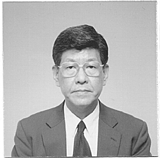
Takeshi Kamiya
ProfessorFaculty of Engineering,
University of Tokyo

|
Takeshi KamiyaProfessorFaculty of Engineering, University of Tokyo |
1. Introduction
It is widely accepted that semiconductor and optoelectronic technologies are two major fundamental hardware technology groups supporting the information society in 21st century. Looking back the history of the physics of light, we can trace to the works of Newton. Even counting from the invention of photography, the modern history of optics has a span of one-and-a-half century. With such a long tradition, however, this science/technology field keeps vigorous pace of progress. I would like to point out here two features behind such vigorous activities (Fig.1).
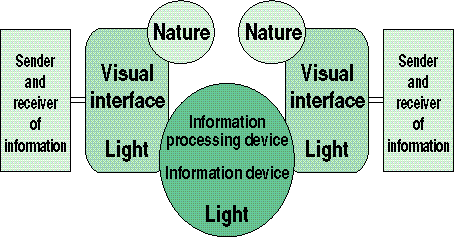
One is the face that light as a physical medium conveying information, permits a huge amount of information capacity. The other feature stems from the fact that visual information will play more and more dominant role in man-machine interface. For example, large capacity and long distance fiber-optic transmission technology and digital optical disc technology realizing the recording of huge amount of information with high fidelity belong to the former, meanwhile the latter includes real time display by television and computer graphics which plays more important role in movies and TV programs.
Extrapolating these trends, it is expected that a more integrated information system will be created combining the technologies of visual data input/output and data processing/transmission storage by optical means, In order to realize such a goal, how far is the modern research on optoelectronics making the progress, and to which direction? This short essay sketched some of the recent topics related to such efforts and discusses the impact of the results.
2. Optical Technology in Multi-Media Age
When we look at the major information services in the latter part of 20th century, we can name TV broadcasting, CATV, computer, fiber-optic telecommunication network, satellite communication, compact disc, video-tape recorder etc., all of which are the outcome of information technology innovation, strongly supported by the technology of electrons and photons. The categorization has been fairly clear, namely broadcasting, computer, public telecommunication, data storage and video display have been organized mostly independently both as technological disciplines and business fields, Renaming them in terms of form of information, we can also count numerical, literal, aural and visual data. Although the mutual conversion of data of different category was not impossible, but very much pains-taking, therefore the interdependency among them has been kept at relatively lower level. Such traditional situation has been changed dramatically because most of these forms of information can be represented by digital signals. In a system functioning transformation, multiplexing, transmission, recognition, or processing of digital data, very flexible treatment of information can be performed irrespective of their forms. This is now called as multi-media information system, and the concept appeared in the beginning of 1980s with the name of ISDN (integrated service with digital network).
Now in the middle of 1990s, already quite a number of commercial products are on the market with the naming such as "multi-media PC" or "multimedia LAN". They are, however, relatively simple systems, which should be regarded as forerunners for the more extensive developments: In the case of PC's, "Multi-media PC" indicates simply such a PC that is equipped with visual data storage by CDROM and stereo speakers via digital sound.
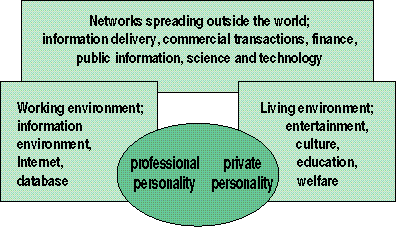
What we expect in 21st century under the name of "multi-media system" his far beyond these simple examples. We are anticipating more innovative system which has the power to influence the life style of ourselves both in professional and private scenes, inducing substantial change in or intellectual life (Fig. 2). It is still difficult how far and how fast the change will proceed, but the recent trend of flexible exchange of information through INTERNET and the new styled of conducting jobs look like showing the correct direction of the big change: we can communicate now globally with almost anyone at anytime, thus realizing the opportunity for collaboration among different organizations with remote location. Another feature is the appearance of virtual huge "bazaar" on the electronic network, where sellers and buyers of goods (or informations) can freely communicate with each other. It proceeded more recently to the point where even payment procedure is executed via "electronic money". The present capacity of INTERNET is still only sufficient for the exchange of symbol data and not enough for real time visual informations, but time will certainly solve the problem. We will soon expand this new trend of economic activities to the innovation in monetary and insurance contracts, in logistics of merchandise and transportation, in services by public servants and so on, gradually transforming the style of professional and private file. The changes will also be accelerated in such fields as entertainment, cultural and educational activities, medicine, social welfare and environmental protection, not only domestic but also international network will contributed to the open development in all facets of life.
Associated with these bright expectation in the future, however, we must have a keen concern on the shadow-side of the change. Namely the security against the leakage of important information through electronic network should be established. In the past and present, some hackers made mischievous actions by invading into other peoples' computer through modem.
With more advanced use of the network including serious sales and legal contracts, dealing with confidential data, much higher level of protection technology should be established very soon. Technologies of cryptography and spread spectrum communication offer the basis for the solution of this problem. Two major requirements to the optoelectronic technology come from such social change: One is the prevision of sufficient channel capacity of communication with ample margin by ultrafast signal transmission and distribution; the other is the technology of efficiently selecting only meaningful informations out of the volume of information input and processing them.
3. Evolution of Optical Information Networks
(Fig. 3)
Currently the maximum data rate commercially available in Japan is 150 Mbit per second. Parallelism is still not yet urgent, overall capacity of 250 thousand TV channels (each 30 Mb/s) is feasible, equivalent of 7.5 Terabit/s throughput. Such futuristic technology complex includes both mature and young technology components, hence further efforts of technological progress should be paid.
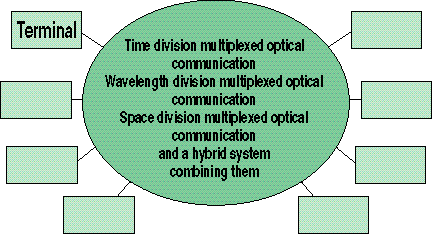
4. Development of Key Technology: Semiconductor optoelectronics and Optical Functional Components (Fig. 4)
The most important devices that dominate the performance of optical systems are the optical active devices like the transistors in integrated circuits. Specifically, these devices include semiconductor lasers, photodiodes, and light modulators made mainly from compound semiconductors.
In fact, the success of long-haul optical communication via low-loss quartz optical fiber is due to the development and implementation of InP-based long wavelength semiconductor lasers. The global prevalence of low-price optical disk players is largely due to the establishment of uniform large-area epitaxial crystal growth technology which boosted the mass production of the GaAs based visible delete lasers. Semiconductor laser technology has evolved into its third generation now but without losing steam.
The Second-generation semiconductor laser from the latter half of the 1980s through the first half of the 1990s introduced an efficient quantum well structure and the strained quantum well structure, which provide both wavelength selectivity and high efficiency. Single-mode DFB lasers also are realized and high-output lasers emitting hundreds of milliwatts which excite high-output erbium dope fiber amplifiers were achieved. One of the topics is the surface light-emitting laser or VCSEL (vertically coupled surface emitting laser). The development of space parallel interconnections using VCSEL is anticipated because of its advantage in I/O coupling.
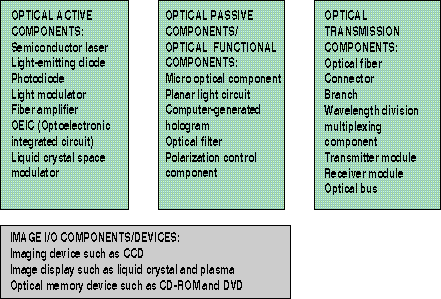
The second topic is low-price, highly-stable, maintenance-free lasers which will be widely used for fiber-to-the-home and a variety of terminals. The third topic of interest is the attempts to generate and control high repetition ultrashort pulses ultimate high-speed signal transmission. High-speed switching and wavelength conversion can be implemented using the non-linearity of semiconductor laser amplifiers. As for receivers, high speed and easy-to-use devices are developed. CCD image input devices has grown remarkably.
The highest data rate in back bone transmission being 10 Gigabit per second, around 60 channels can be conveyed through each fiber. On the other hand, single channel of digital color TV requires a data rate of 1 megabit per second if no data compression technique is applied. A service of several tens of channels of them to individual home requires a capacity around 1 Gbit/s. A LAN or CATV systems covering one thousand homes requires total of 1000 Gbit/s, or 1 Terabit/s. Since future multi-media systems provide not only with video-on-demand (VOD) but also with shopping and contracting and so on, it is strongly required to construct networks with ample channel capacity. Fortunately optical means can multiplexing signal in three different ways; namely in time (TDM), wavelength (WDM) and space (SDM) domains (TDM stands for time division multiplexing) (Fig. 3). To transmit signals to distant receiving point, we need to use light wavelength for which the transmission loss of optical fibers. For fused silica (or quarts) optical fiber, loss in minimized at wavelength range around 1.3 and 1.5 micrometer (ɠm). Long distance fiber optic transmission uses therefore always these wavelength ranges. The frontier of R & D in time domain reached 200 Gbit/s, meanwhile WDM with 1000 wavelengths is under planning. While large scale implementation plan of space with the progressive complexity of optical systems, requirements of assembly technology are boosted. It is natural that more emphasis is put on the development of such components as micro-optics, guided-wave integrated photonics, computer-generated holograms and a variety of optical functional devices based on these. A group of NTT applied the VAD-like CVD technique to the fabricating planar waveguide structures [VAD is a successful invention by NTT to produce high quality optical fiber preforms with large throughput]. This new technique created a variety of optical circuit components, named as planar lightwave circuit, or PLC. Already this technique is regarded as fundamentals for advanced WDM modules. In the field of image I/O equipment, new functional components such as functional filters, adaptive optics or new type display cells may act as breakthrough for historic change just as the significant progress of color CRT with black matrix screen structure prepared a revolutionary jump in video market in the past. Therefore we need to keep watching carefully the technological progress of liquid crystal, plasma, and vacuum microelectronic display cells.
Another important aspect in predicting the future of optical technology is certainly the interface to electronic circuits. In some case the driver IC for optoelectronic components forms the critical path for better performance. These are especially important in designing optical interconnect modules and OEIC's. From material aspects a continuing efforts to assemble silicon and compound semiconductor are coming close to end. Namely impressive results are reported recently both on heteropolarity on silicon substrates and on microscopic adhesion of hetero wafers.
5. Trials Toward Optical Computing and Optical Interconnection
One of the important concepts to directly connect optics and information is "optical computing". Since just after the invention of laser, a variety of schemes computing optically either in a digital or analog manner have been proposed, and some were experimentally demonstrated. However, with the exception of small scale trials, no great success in computer business was reported yet. On the other hand many people think potential of optical information processing is still very high.
Specifically if parallel transmission and processing parts are implemented optically, the performance of parallel image processing system should be substantially up-grated, enabling real time execution of sophisticated processing. Therefore the level of curiosity among professionals on this field is being kept rather high. In Japan, the national research project under the name of "Real World Computing" (RWCP) accommodates optical computing as one of the major targets. Another impetus is the international topical meeting on optical computing held in April 1996 in Sendai, Japan, collocating with the topical meeting on photonics in switching (OC'96 and PS'96). The Japanese researchers are thus activated from the observation of domestic and international publications and presentations.

Considering the systems aspect of optical computing the relationship to electronic processing (or computer processing) should be studied carefully. With the progress of computers and data storage, the interface of optical computing unit to them are automatically changing (Fig. 5). Even if the principles of optical computation are preserved, their performance can be multiple depending on the introduction of new technology for their implementation. For such purpose efforts are being paid to develop novel components by using semiconductor optoelectronics, liquid crystals, computer-generated-holography and so on.
6. Summary
The progress in optical technology is rapid and multi-fold, In contrast to the early time of laser or optoelectronics research, it is not easy for individual researcher to grasp the whole feature. It is a general tendency to pick up relatively narrow research targets and to study toward in-depth direction. Research groups aiming at the future breakthroughs belonging either to public research laboratories, universities or dedicated research consortia, should be conscious to keep trucks looking both at near and far goals.
I believe optoelectronics is an indispensable research target area, where the firm platform for future information technology should be built, with which our country can contribute to the creation of high value-adding industry and to the goal of global information society. As one of the researchers in this promising field, I am happy to try.